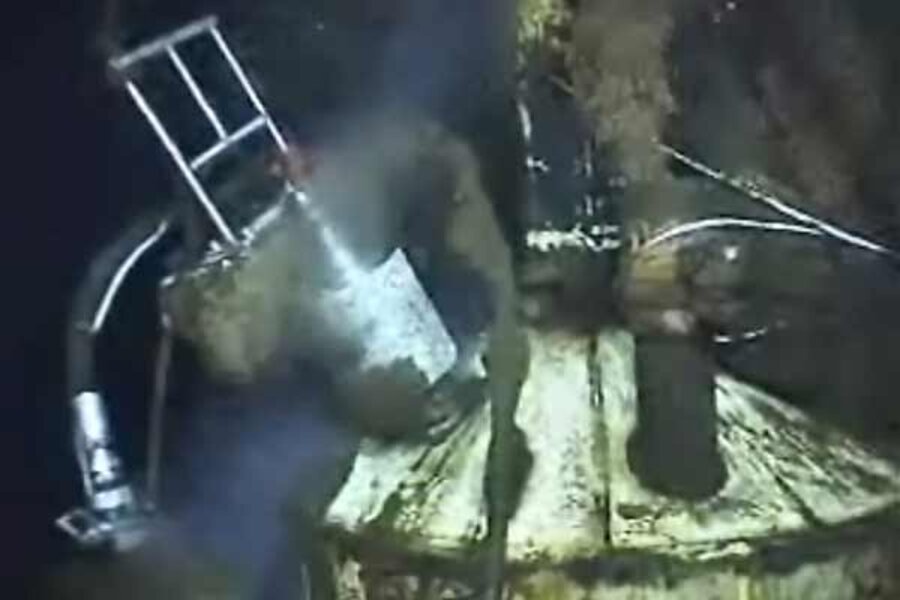Methane's hidden impact in Gulf oil spill
Loading...
The BP oil blowout, now into its 11th week, is releasing large quantities of methane into the ocean, most of which is remaining dissolved in the waters deep beneath the surface.
The gas represents an under-appreciated pollutant in a drill-rig disaster that has pumped as much as 60,000 barrels (2.5 million gallons) of oil a day into the Gulf of Mexico, researchers say.
Unlike the oil, the methane isn't coating birds or fouling beaches and wetlands. But it has the potential to wreak havoc on important links in the undersea food chain, researchers say.
By volume, some 40 percent of the hydrocarbons in the reservoir the Deepwater Horizon tapped is gas, of which 95 percent is methane, notes Samantha Joye, a marine scientist at the University of Georgia who has been gathering data at sea on the methane plumes.
By weight, she and her colleagues estimate, for every ton of oil spewing from the broken riser pipe, a half a ton of gas is blasting upward as well. "That's a tremendous amount of gas coming into the water column," she says.
Yet gas data represents the largest gap in efforts to take the full measure of the blowout, Dr. Joye says. That gap results from "the perception that it doesn't really matter; the focus is on oil, oil, oil."
Oil clearly has its own set of serious environmental effects. But the gas's behavior and fate at depth also is relevant to gauging the blowout's full ecological impact.
"It's not the same as the oil, but it's a big number," Joye says. "We have to get a handle on it, and we don't have a handle on it right now."
As with the undersea oil clouds researchers have been hunting, the main concern regarding methane is the possibility that the action of methane-munching microbes could exhaust oxygen in the affected layers.
That low-oxygen condition would threaten small marine organisms – plankton, fish larvae, and other creatures that can't roam large distances and form a vital link in the marine food chain. If a low-oxygen plume were to glide across the bottom on the continental shelf, it could have a similar effect on corals and shellfish.
"We've never dealt with a situation like this before," Joye says. The closest analogues appear in the paleo-oceanographic record, "when there have been these methane burps over geologic time scales."
There, she says, the evidence is strong for a run-up in microbe populations that feed on the methane and for the significant draw-down of oxygen that accompanies their feast. But the paleo record is silent on the fall-out for higher levels of the food chain.
That most of the leaking methane is hunkering down at depth is evident in measurements researchers have been taking in the Gulf.
A 10-day research cruise in mid-June took measurements over a distance that ranged from about 1,600 feet from the blowout to eight miles away. The team, led by David Valentine from the University of California at Santa Barbara and John Kessler from Texas A&M University, found that methane concentrations "were low in the surface water and overlying air, very high at depths greater than 3,000 feet, and somewhat elevated in between," Dr. Valentine writes in an email exchange.
"We are interpreting this data to mean that the vast majority of the methane that escapes the top hat is trapped at depths of around one kilometer, and that only small amounts are likely to escape through the ocean to the atmosphere," he says.
The methane remains a captive of deep water because in temperate and tropical oceans, sea water forms stable layers that don't readily mix upward, he explains.
During a research cruise in late May, Joye and her colleagues gathered measurements in some 90 locations inside a 30 mile by 40 mile "box" of ocean near the drill site. At each location, the team lowered an array of sampling bottles – each triggered to capture a water sample at a different depth.
Analysis of the dissolved gas content in the samples revealed a layer within five miles of the blowout in which the dissolved methane was six times higher than the dissolved oxygen. The 600-foot thick layer of water ranged in depth from 3,300 feet to 4,300 feet below the surface.
The bottom line: Methane-loving microbes would find themselves in the equivalent of an all-you-can-eat-and-then-some diner.
Enough food – the methane – is present that, in principle, microbes could use up all of the oxygen in that "lens" of seawater, dropping oxygen levels to zero – a level more akin to the bottom of the Black Sea than to the Gulf of Mexico's annual oxygen-depleted "dead zone."
That breakdown of methane occurs very slowly. And in practice, Joye cautions, microbes need oxygen, too. So at some point their activity could slow or stop before all of the oxygen in a methane-heavy parcel of water disappeared.
Still, microbial breakdown of the methane could reduce oxygen concentrations to levels untenable for a range of marine creatures. And just as a lack of vertical mixing in the deep water is holding the dissolved methane at depth, that lack of mixing keeps high levels of dissolved oxygen at the surface from replenishing oxygen levels in the deep water.
Related:





